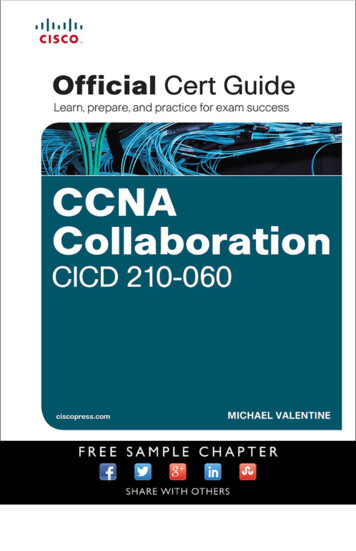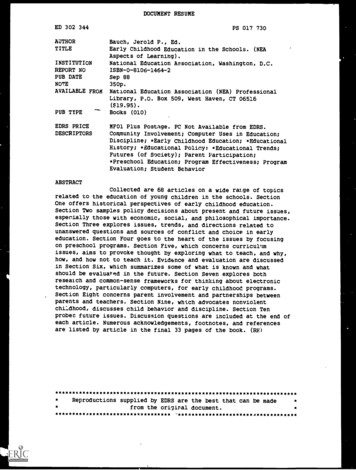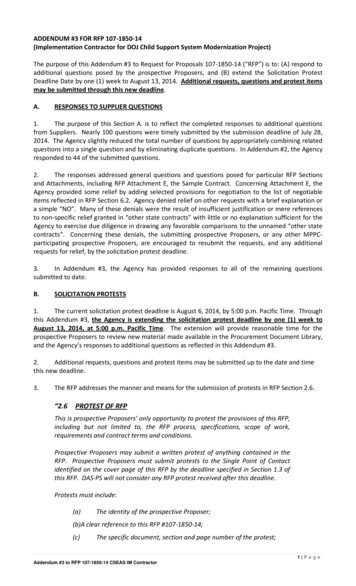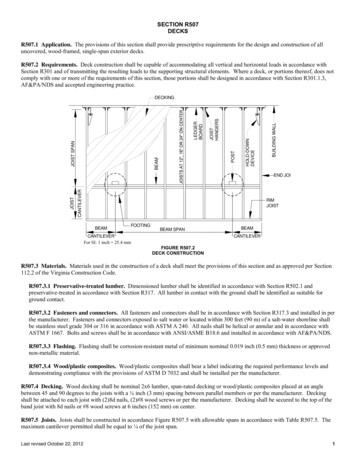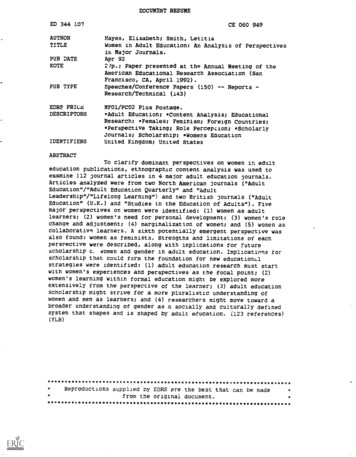
Transcription
DOCUMSNT RESUMEED 344 107AUTHORTITLEPUB DATENOTEPUB TYPEEDRS PRICEDESCRIPTORSIDENTIFIERSCE 060 949Hayes, Elisabeth; Smith, LetitiaWomen in Adult Education: An Analysis of Perspectivesin Major Journals.Apr 9227p.; Paper presented at the Annual Meeting of theAmerican Educational Research Association (SanFrancisco, CA, April 1992).Speeches/Conference Papers (150) -- Reports Research/Technical (143)MF01/PCO2 Plus Postage.*Adult Education; *Content Analysis; EducationalResearch; *Females; Feminism; Foreign Countries;*Perspective Taking; Role Percepcion; *ScholarlyJournals; Scholarship; *Womens EducationUnited Kingdom; United StatesABSTRACTTo clarify dominant perspectives on women in adulteducation publications, ethnographic content analysis was used toexamine 112 journal articles in 4 major adult education journals.Articles analyzed were from two North American journals ("AdultEducation"/"Adult Education Quarterly" and "AdultLeadership"/"Lifelong Learning") and two British journals ("AdultEducation" (U.K.) and "Studies in the Education of Adults"). Fivemajor perspectives on women were identified: (1) women as adultlearners; (2) women's need for personal development; (3) women's rolechange and adjustment; (4) marginalization of women; and (5) women ascollaborative learners. A sixth potentially emergent perspective wasalso found: women as feminists. Strengths and limitations of eachperspective were described, along with implications for futurescholarship c. women and gender in adult education. Implications forscholarship that could form the foundation for new educationiastrategies were identified: (1) adult education research must startwith women's experiences and perspectives as the focal point; (2)women's learning within formal education might be explored moreextensively from the perspective of the learner; (3) adult educationscholarship might strive for a more pluralistic understanding ofwomen and men as learners; and (4) researchers might move toward abroader understanding of gender as a socially and culturally definedsystem that shapes and is shaped by adult education. (123 ************************************Reproductions supplied by EDRS are the best that can be madefrom the original *******M*****************It**
astWOMEN IN ADULT EDUCATION:AN ANALYSIS OF PERSPECTIVES IN MAJOR JOURNALSbyElisabeth HayesUniversity of Wisconsin-MadisonandLetitia SmithSyracuse UniversityAbstractThe purpose of this study was to clarify dominant perspectives onwomen in adult education publications. Ethnographic contentanalysis was used to analyze 112 journal articles in four majoradulteducationjournals.Five dominant perspectiveswereidentified, along with a sixth potentially emergent perspective.Strengths and limitations of each perspective are discussed, alongwith implications for future scholarship on women and gender inadult education.Contact Person: Elisabeth HayesUniversity of Wisconsin-MadisonDept. of Continuing & Vocational Education276 Teacher Education BuildingMadison, WI 53706(608) 263-0774BITNET: ERRAYES@WISCMACCPaper to he presented at the 1992 American Educational ResearchAssociation Conference, San Francisco, CA, April 1992II Et DEPARTMENT OF EDUCATION"PERMISSION TO REPRODUCE THISMATERIAL HAS BEEN GRANTED 1,,CATIrM AI RE sounrsce (NJ OPMATFONCENTERIMOTr,fr riot imIcent haS tvenr, rortroow ediik,ref evect from fry ryerson or orgarlaat.,,r,tqviititinu It:M.nor (. flange% Nave [Wen ,,,arte to mpro,.resvoCtuf t,on guaotyF-',.,01% of vwe,:Ip"onS Stilted!Ns thnr,,Pni (10 001 nec'eS4ardy ,orrt"4tOFWW%4K),IWWW,TO THE EDUCAtTIONAL RESOURCESINFORMATION CENTER (ERIC)OM, ,k41rV" L.-;;'7.;, ;'
WOMEN IN ADULT EDUCATION:AN ANALYSIS OF PERSPECTIVES IN MAJOR JOURNALSIntroductionSince the early 197is, feminist scholars have raised importantcriticisms regarding the exclusion and misrepresentation of womenand women's experiences in previous scholarship. As a result, therehas been a tremendous growth in research and theory that hasgenerated new perspectives on women and gender. These perspectivesare quite diverse, reflecting varied assumptions about women'sexperiences and characteristics.To clarify and evaluate these assumptions, a number ofscholars have developed classification schemes or models foranalyzing scholarship on women in specific disciplines, such aspsychology (Crawford & Marecek, 1989) and sociology (Ward & Grant,1995). For example, Crawford and Marecek (1989) suggest thatpsychological research on women and gender has been guided by fourdifferent conceptual frameworks: exceptional women; women asproblem (or anomaly); the psychology of gender; and transformation.While the authors point out certain benefits of each approach, theyalso identify significant potential problems with each of the first(1985) based a classificationscheme on themes from feminist critiques of sociological research.They identified three types of articles with a focus on women orthree frameworks. Ward and Grantgender. These types included additions, modifications, and recasts.The researchers used this typology to classify articles publishedin sociology journals over a ten year period. Their findingsrevealed only a small percentage of "recast" articles, which offerthe most significant reconceptualizations of theory on women andgender.Tetrault (1985) presents one of the most comprehensive anddetailed models for analyzing scholarship on women. She identifiedwhat she describes as five common phases of thinking about women:male scholarship; compensatory scholarship; bifocal scholarship,feminist scholarship; and multifocalfrelational scholarship. Thesephases were identified through a review of literature inand wereand psychology,literature,anthropology, history,intended to be applicable across disciplines. Her model was used toassess faculty members' conceptualizations of women, women'sstudies curricula, and the images of women in textbooks. Among herfindings was the discovery that high school history texts did notgo beyond the third phase of scholarship in their treatment ofwomen, and thus had significant limitations.The work of Tetrault (1985) and these other authors indicatethe importance of clarifying new and old assumptions about womenthat guide both research and educational programs in a discipline,to determine how adequately women's needs and experiences areaddressed. One growing body of scholarship that has received 3ittleattention in previous feminist analyses is associated with thefield of adult education. The practical as well as academicsignificance of adult education makes its knowledge base an object13
particular interest for educators and feminist scholars.Increasing numbers of adults are enrclling in higher education;business and industry are devoting greater resources to trainingand education; adult literacy education is the object of new publicinterest and government support. A growing number of doctorates arebeing awarded in the field and opportunities for graduate study aresignificant number of students,aaddition,Inexpanding.educators, and administrators in all areas of adult education arewomen. Accordingly, women and gender are presumably salient topicsimportantin the field and feminist scholarship would haveimplications for the literature.Through an analysis of publications on women in major adulteducatlon journals, this study sought to identify and evaluate theadultperspectives on women that have influenced mainstreamcentraltheSpecifically,education research and practice.addressthe question: what are theobjective of this study was toeducationdomiaant perspectives on women in selected adultofpublications? The results ofthe study promised to provide afoundation for future research and theory-building in relatial towomen and gender issues in adult education.MethodologyData SourceThe primary data base for this analysis was drawn from anearlier quantitative analysis of publications on women and genderin adult education journals (Hayes, 1992). Four primary sourceswere selected for analysis. These included two North Americanjournals, Adult Education/Adult Education Quarterly (AE/AE0), Adultexperienced a change in name during the period of analysis); andtwo British journals, Adult Education (U.K.) (AEBR) ahd Studies inthe Education of Adults (SEA). Two of the journals are primarilytwo publishresearch-oriented (AEO and SEA) while the otherpractice-oriented articles. These journals were selected for theinitial study according to two criteria that were also relevant toFirst, to obtain a broad assessment ofthe present analysis.dominant perspectives, it was considered important to examinejournals that publish articles on a wide range of adult educationsubfields, rather than more specialized publications. Thesejournals also have national circulations and thus presumablyrepresent the more influential publications in the field overall.Secondly, it was necessary that the journal had been in publicationfor a sufficient duration to permit analysis of trends over time.Specifically, these journals were selected since they had begunpublication by the late 1960s, prior to the widespread emergence offeminist scholarship. Although this was not a primary purpose ofthe study, comparison of earlier and later perspectives might besuggestive of the impact of this feminist scholarsl-ip on theidentified perspectives. Finally, for the purpose of the presentstudy, these diverse journals permitted the identification ofthemes and topics that cross-cut specific educational settings andpopulations, and that relate to both research and educationalpractice.24
types of journal articles were selected foranalysis. The first type included articles that dealt explicitlywith women in adult education or women's educational programs. Thesecond type included articles dealing with gender differences. ToTwo majorrepresent past as well as present perspectives, articles in thedata base from the earlier study were drawn from publications from1966 to 1988; for the present study, publications in 1989 and 1990were also raviewed for appropriate articles. A total of 112articles met the criteria and were included in the analysis.Data AnalysisIt Was initially planned to use Tetrault's (1985) framework asthe basis for this study, and to categorize articles according tothe five stages that she identified. However, preliminary analysessuggested that her categories were too broad to representadequately the perspectives on women that were reflected in theadult education literature. Accordingly, a grounded theory approachwas used in this research, allowing for the generation of themesand categories specific to literature on women in adult education.This approach offered a more detailed picture of adult educationgreaterato promoteand promisedscholarship on women,adulteducationguideunderstanding of the assumptions thatresearch and practice.Given this exploratory nature of the study, ethnographiccontent analysis was used as the research methodology. In thisapproach, themes and categories are generated through the datarather than fitting the data into predeterminedanalysis,Three key questionscategories (Altheide, 1987; Kasworm, 1990).guided the analysis of each article: How are women described? Howare similarities/differences between women and men described andexplained? What educational strategies for women are suggested?Comparative analysis of emergi:ig themes led to the development ofmajor conceptual categories or frameworks representing keyperspectives on women in adult ectucation. Each perspectiveconsisted of certain assumptions about women's most distinctivecharacteristics as individuals and adult learners. Implicit orexplicit in each perspective were also certain beliefs about theorigins of these characteristics. Each article was categorizedAfter this initialaccording to its dominant perspective.categorization, the articles in each perspective were againreviewed to identify potential clusters within perspectives, basedon the authors' focus on specific aspects of women's experience inrelationship to adult education.Reliability is always a particular concern in qualitativestudias such as this one. To establish reliability, two researcherswere involved in data analysis. Each researcher analyzed andcategorized articles independently. Articles from each journal wereanalyzed in small groups. After each group was analyzed andcategorized/ any discrepancies between researchers were noted andresolved through re-analysis or further refinement of theconceptual framework.At least two limitations of the study and its methodology maybe noted. First, while the nature of each perspective and the35
categorization of each article was validated independently by thefindings may have beentwo co-researchers, the analysis andperspectives;this is a limitationaffected by the researchers' ownsuch asinherent in all qualitative studies. Second, categoriesthose identified in this study can somewhat obscure the variationsperspectives, asthat exist between articles with similar dominant perspectives.Anwell as the similarities that can be seen acrosssimilaritiesintheattempt is made to note these variations andUltimately, the identifieddescription of each perspective. reflectionupon and furtherframework is intended to promotein adult education.analysis of dominant assumptions about women categories,nor allThe framework does not represent absolutepossible perspectives that might be identified in the literature.FindingsFive major perspectives on women were identified through thecontent analysis. The perspectives included:(1) women as adult learners;(2) women's need for personal development;(3) women's role change and adjustment;(4) marginalization of women;(5) women as collaborative learners.In addition, a sixth perspective, labelled "women as feminist," wassuggested by one article, which will be discussed separately. Keyassumptions and educational implications of each perspective aredescribed below.Women as Adult LearnersKey' Assumptions. In this perspective, women were treated as aparticular group of learners defined by their sex. The dominantconcern was not "women learners" but rather adult learners, whohappen to be women. Typically, women were the object of attentionabecause they hadn't previously been studied, because they had Nocertain attribute of interest, or simply due to convenience.special importance was given to gender in relation to women's livesor learning. The sixteen articles that shared this perspectivecould be differentiated to some extent according to content:research studies or program descriptions.Research studies. Eight articles described research studieset al,that utilized all-female samples. In six articles (Blais1989; Clayton & Smith, 1987; Fagin, 1971; Hochman, 1981; Johnson etal., 1974; Tucker & Huerta, 1987), the topic of interest was onedrawn from general adult education theory or practice, and womenabout thewere selected for study to add to general esetopic.participation, deterrents to participation, the relationship ofCollegeprison education to recidivism, adult performance on thetasks,andLevel Examination Placement tests, adult developmentaladjustment to old age. In some cases, women had not been includedthey hadin previous investigations of the topic; in other casesbeen part of mixed gender samples. In both instances, Fagin's(1971) comment is typical of the rationale for studying women:One of the major purposes of the College Level Placement46
Program (CLEF') is to give adults an opportunity to secureA gap remains,college level credit by examinationdataarelackingtoshow whetherhowever: to date masses ofadults in the general population - particularly women - canperform acceptably on such examinations (pp. 148-149).In one article (Strychar, Griffith, Conroy & Sork, 1990), alearning opportunity unique to women - pregnancy - was the objectof interest. However, the gender of the learners did not appearimportant except as a factor that delineated the researchpopulation; findings were related to general research and theories&about self-directed learning. In a second article (AtkinHutchinson, 1981), responses in a women's magazine to an articleabout mothers returning to school were studied, but the purpose andconclusions of the study addressed the general need for informationdissemination about educational opportunities.1981)Finally, one research study (Merriam & Mullins,associated with this perspective utilized a sample comprised ofboth women and men in a study of adult developmental tasks. Womenand men were treated as separate groups in part of the analysis,differences between the two groups were identified and attributedto traditional role-related concerns. These differences led to thediscussion of women as particularly responsive to adult educationprograms based on developmental tasks.Program Descriptions. Six articles (Buckey, Freeark, & O'Barr,1976; Greenblatt, 1968; Hoist & Rouls, 1972; Rosenthiel, 1969;Stamper & Jones, 1989; Thompson, Ameiss, Wood, & Fagin, 1970)described adult education programs for women. While authorsoccasionally noted how program elements might accomodate aparticular need of women, such as flexible scheduling, for the mostpart the gender of the learners was not noted as significant;frequently the students were described in terms such as adultlearners or mature students. The emphasis was primarily ondescribing program characteristics and implications for adulteducation provision in general. For example, Thompson et al. (1970)described a program designed totrain housewives as computerprogrammers; their primary purpose was to demonstrate how employersmight successfully recruit and train part-time employees forspecific workplace needs.Finally, one article (Hill, 1979) described an individualwoman's experiences as a returning student. The title of thearticle, "Celebrating the Adult Learner," indicates the "genderneutral" nature of the discussion. Although the author notes thather father made her leave school because she was a girl, she makesno explicit connection between her identity as a woman and herexperiences as an adult student.Educational Implications. As noted above, implications ofresearch results and program descriptions often were statedin terms of general adult education theory and practice. Wheneducational approaches specifically for women were identified,strategies to recruit and retain women students were mostfrequently suggested. The need for childcare, flexible scheduling,5
and financial assistance were among the typical recommendations. Amarketing orientation, in which women were considered to be one ofmany potential target groups for adult education, was reflected inthe most responsive consumers of programscomments such as h.based on the [adult developmental] tasks would be females, middleincome adults and older adults" (Merriam & Mullin, 1981, p. 138).While commonly women were treated as a homogeneous group, a few.articles did note potential differences among women based oncharacteristics such as age or income. Tucker and Huerta (1987)were the only authors that addressed the educational needs of anethnic minority group of women.Personal DevelopmntEmlyAmmtiona. The dominant concern in 32 articles waswomen's need for pacsonal development. These articles characterizedwomen as deficient in personal attributes such as self-esteem andself-confidence, as well as in social skills, communication skillsand academic skills. Typically these deficiencies were attributedassumedto women's generalized experiences as homemakers; it waswiththethat this experience included relatively limited contactchildren.Inworld outside the home and primary interaction withsome articles, women's skill deficiencies were also a
ED 344 107. CE 060 949. AUTHOR Hayes, Elisabeth; Smith, Letitia. TITLE. Women in Adult Education: An Analysis of Perspectives. in Major Journals. PUB DATE Apr 92 NOTE. 27p.; Paper presented at the Annual Meeting of the. American Educational Research Association (San. Francisco, CA, April 1992

